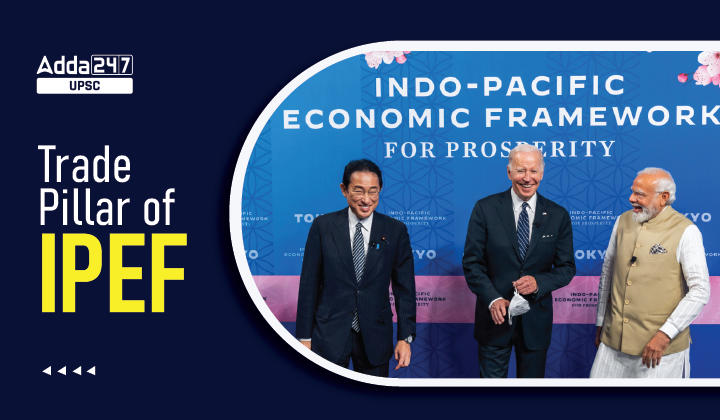Table of Contents
Trade pillar of IPEF- Relevance for UPSC Exam
General Studies II- Groupings & Agreements Involving India and/or Affecting India’s Interests.
In News
India stayed out of the joint declaration on the trade pillar of the US-led Indo-Pacific Economic Framework (IPEF) ministerial meet in Los Angeles, with Union Commerce Minister citing concerns over possible discrimination against developing economies.
Why did India opt out of the trade pillar?
- One of the reasons for staying out of the trade pillar was that the contours of the framework had not emerged yet.
- This is particularly about the kind of commitment each country would have to make on “environment, labour, digital trade and public procurement”.
- India’s decision also mirrors the decision to walk out after seven years of negotiations from the Regional Comprehensive Economic Partnership (RCEP).
What is IPEF?
- It is a US-led framework for participating countries to solidify their relationships and engage in crucial economic and trade matters that concern the region, such as building resilient supply chains battered by the pandemic.
- It is not a free trade agreement. No market access or tariff reductions have been outlined, although experts say it can pave the way to trade deals.
Members of IPEF
- The member nations include Australia, Brunei, India, Indonesia, Japan, South Korea, Malaysia, New Zealand, the Philippines, Singapore, Thailand and Vietnam.
- It includes seven out of 10 members of the Association of South East Asian Nations (ASEAN), all four Quad countries, and New Zealand.
- Together, these countries account for 40 per cent of the global GDP.
Four pillars of IPEF
- Trade that will include digital economy and emerging technology, labor commitments, the environment, trade facilitation, transparency and good regulatory practices, and corporate accountability, standards on cross-border data flow and data localisations;
- Supply chain resilience to develop “a first-of-its-kind supply chain agreement” that would anticipate and prevent disruptions;
- Clean energy and decarbonization that will include agreements on “high-ambition commitments” such as renewable energy targets, carbon removal purchasing commitments, energy efficiency standards, and new measures to combat methane emissions; and
- Tax and anti-corruption, with commitments to enact and enforce “effective tax, anti-money laundering, anti-bribery schemes in line with [American] values”.
How do members participate?
- Countries are free to join (or not join) initiatives under any of the stipulated pillars but are expected to adhere to all commitments once they enrol.
- Negotiations are meant to determine and list the provisions under each pillar and open the floor for countries to choose their ‘commitments’.
- The framework would be open to other countries willing to join in the future provided they are willing to adhere to the stipulated goals and other necessary obligations.
Reasons for the creation of IPEF
- US regaining lost credibility: IPEF is also seen as a means by which the US is trying to regain credibility in the region after Trump pulled out of the Trans Pacific Partnership TPP).
- Rising Chinese influence: Since then, there has been concern over the absence of a credible US economic and trade strategy to counter China’s economic influence in the region.
- Competing RCEP: It is also in the 14-member Regional Comprehensive Economic Partnership, of which the US is not a member (India withdrew from RCEP).
- “Pivot to Asia” strategy: US has intensified its engagement with the wider Asia-Pacific region to advance its economic and geopolitical interests.
India’s perception of IPEF
- PM Modi described the grouping as born from a collective desire to make the Indo-Pacific region an engine of global economic growth.
- India has called for common and creative solutions to tackle economic challenges in the Indo-Pacific region.
What does it have to do with China?
- The US strategists believe the US lacks an economic and trade strategy to counter China’s increasing economic influence in the region since 2017.
- US companies are looking to move away from manufacturing in China.
- IPEF would therefore offer an advantage to participating countries, allowing them to bring those businesses into their territory.
- However, it officially excluded Taiwan despite its willingness and economic merit to join.
- This exhibits Washington’s geopolitical caution.
Reactions from the opponents
- Chinese Foreign Minister Wang Yi criticized the initiative as an attempt to further economic decoupling from China.
- He argued that the initiative, and the US Indo-Pacific strategy as a whole, created divisions and incited confrontation. It is destined to be ultimately be a failure.
- Taiwan was excluded in order to appease key “fence-sitter” countries such as Indonesia whose governments feared angering China.
Issues with IPEF framework
- IPEF would neither constitute a ‘free trade agreement,’ nor a forum to discuss tariff reductions or increasing market access.
- Unlike a traditional trade agreement, the US administration will not need congressional approval to act under the IPEF. Hence its legal status is questionable.
- This also raises doubts among potential participants about their reluctance to offer significant concessions under the agreement.
- The volatility of US domestic politics has raised concerns about IPEF’s durability.
- Unlike traditional FTAs, the IPEF does not subscribe to the single undertaking principle, where all items on the agenda are negotiated simultaneously.
Given the divisive nature of American politics, it is unclear whether the IPEF will survive past the Biden administration.
Way forward
- The IPEF’s launch in Tokyo was symbolic in nature; bringing the IPEF to fruition will involve significant domestic and international challenges.
- Without ratification by Congress, the IPEF’s fortunes will remain in limbo.
- Going forward, the US and the founding partners need to develop the process and criteria by which other countries from the region will be invited to join the negotiations on the IPEF.



 UPSC Prelims Exam Date 2024, Check New E...
UPSC Prelims Exam Date 2024, Check New E...
 UPSC Eligibility Criteria 2024- Age Limi...
UPSC Eligibility Criteria 2024- Age Limi...
 UKPSC RO ARO Result 2024 Out, Download M...
UKPSC RO ARO Result 2024 Out, Download M...







